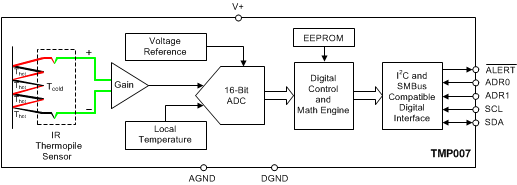SBOS685C April 2014 – July 2015 TMP007
PRODUCTION DATA.
- 1 Features
- 2 Applications
- 3 Description
- 4 Revision History
- 5 Pin Configuration and Functions
- 6 Specifications
-
7 Detailed Description
- 7.1 Overview
- 7.2 Functional Block Diagram
- 7.3
Feature Description
- 7.3.1 Spectral Responsivity
- 7.3.2 Field of View and Angular Response
- 7.3.3 Thermopile Principles and Operation
- 7.3.4 Object Temperature Calculation
- 7.3.5 Calibration
- 7.3.6 Sensor Voltage Format
- 7.3.7 Temperature Format
- 7.3.8 Serial Interface
- 7.4 Device Functional Modes
- 7.5
Register Maps
- 7.5.1 Sensor Voltage Result Register (address = 00h) [reset = 0000h]
- 7.5.2 TDIE Local Temperature Result Register (address = 01h) [reset = 0000h]
- 7.5.3 Configuration Register (address = 02h) [reset = 1440h]
- 7.5.4 TOBJ Object Temperature Result Register (address = 03h) [reset = 0000h]
- 7.5.5 Status Register (address = 04h) [reset = 0000h]
- 7.5.6 Status Mask and Enable Register (address = 05h) [reset = 0000h]
- 7.5.7 TOBJ Object Temperature High-Limit Register (address = 06h) [reset = 7FC0h]
- 7.5.8 TOBJ Object Temperature Low-Limit Register (address = 07h) [reset = 8000h]
- 7.5.9 TDIE Local Temperature High-Limit Register (address = 08h) [reset = 7FC0h]
- 7.5.10 TDIE Local Temperature Low-Limit Register (address = 09h) [reset = 8000h]
- 7.5.11
Coefficient Registers
- 7.5.11.1 S0 Coefficient Register (address = 0Ah) [reset = 260Eh]
- 7.5.11.2 A1 Coefficient Register (address = 0Bh) [reset = 0106h]
- 7.5.11.3 A2 Coefficient Register (address = 0Ch) [reset = FF9Bh]
- 7.5.11.4 B0 Coefficient Register (address = 0Dh) [reset = FF3Ah]
- 7.5.11.5 B1 Coefficient Register (address = 0Eh) [reset = FF71h]
- 7.5.11.6 B2 Coefficient Register (address = 0Fh) [reset = 0553h]
- 7.5.11.7 C2 Coefficient Register (address = 10h) [reset = 0000h]
- 7.5.11.8 TC0 Coefficient Register (address = 11h) [reset = 0034h]
- 7.5.11.9 TC1 Coefficient Register (address = 12h) [reset = 0000h]
- 7.5.12 Manufacturer ID Register (address = 1Eh) [reset = 5449h]
- 7.5.13 Device ID Register (address = 1Fh) [reset = 0078h]
- 7.5.14 Memory Access Register (address = 2Ah) [reset = 0000h]
- 8 Application and Implementation
- 9 Power-Supply Recommendations
- 10Layout
- 11Device and Documentation Support
- 12Mechanical, Packaging, and Orderable Information
Package Options
Mechanical Data (Package|Pins)
- YZF|8
Thermal pad, mechanical data (Package|Pins)
Orderable Information
1 Features
- Integrated MEMS Thermopile for Noncontact Temperature Sensing
- 14-Bit Local Temperature Sensor for Cold Junction Reference
- ±1°C (max) from 0°C to +60°C
- ±1.5°C (max) from –40°C to +125°C
- Integrated Math Engine
- Directly Read Object Temperature
- Programmable Alerts
- Nonvolatile Memory for Storing Calibration Coefficients
- Transient Correction
- Two-Wire Serial Interface Options
- I2C and SMBus Compatible
- Eight Programmable Addresses
- Low Power
- Supply: 2.5 V to 5.5 V
- Active Current: 270 μA (typ)
- 2-µA Shutdown (max)
- Compact Package
- 1.9-mm × 1.9-mm × 0.625-mm DSBGA
2 Applications
- Noncontact Temperature Sensing
- Case Temperature
- Laser Printers
- Power Relays
- Health and Beauty
- HVAC Comfort Optimization
- Gas Concentration
- Flame Detection
3 Description
The TMP007 is a fully-integrated microelectro-mechanical system (MEMS) thermopile sensor that measures the temperature of an object without direct contact. The thermopile absorbs passive infrared energy from an object at wavelengths between 4 um to 16 um within the end-user defined field of view.
The internal math engine combines the corresponding change in voltage across the thermopile with the internal cold-junction reference temperature sensor to calculate the target object temperature. The TMP007 also provides nonvolatile memory for storing calibration coefficients.
The TMP007 is designed with portability and power in mind, and can easily be placed in the tightest of spaces while using standard surface-mount assembly processes. Low power consumption also makes it well suited for battery-powered applications.
The TMP006 offers a reduced feature set. The TMP006 offers similar performance as the TMP007, but does not contain the math engine or nonvolatile memory.
The Infrared thermopile sensor is specified to operate from –40°C to +125°C. It is possible to measure object temperature beyond the device operating range as long as the device itself does not exceed the operating temperature range (–40°C to +125°C).
Device Information(1)
| PART NUMBER | PACKAGE | BODY SIZE (NOM) |
|---|---|---|
| TMP007 | DSBGA (8) | 1.90 mm × 1.90 mm |
- For all available packages, see the package option addendum at the end of the datasheet.
